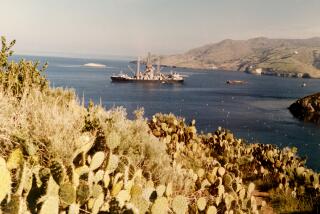Mayday : EISENHOWER, KHRUSHCHEV AND THE U-2 AFFAIR by Michael R. Beschloss (Harper & Row: $19.95; 544 pp., illustrated)
- Share via
The U-2 overflights of the Soviet Union mark a high point in the Cold War in the 1950s. For nearly four years, these high-flying American reconnaissance planes flew unchallenged over Russia, bringing back extremely valuable pictures of Soviet military installations.
This secret information permitted President Dwight D. Eisenhower to resist the clamor following Sputnik in October, 1957, for a massive increase in American defense spending. Despite charges of a dangerous missile gap, the intelligence gathered by the U-2 cameras showed that the Russians did not have an operational ICBM prior to 1960, and thus gave Eisenhower time to develop a second generation of American missiles, notably the solid-fueled Polaris and Minuteman, that in fact gave the United States the strategic advantage over the Soviets throughout the 1960s.
But the Soviet success in downing the U-2 piloted by Francis Gary Powers on the eve of the Paris summit conference left the United States with a terrible black eye before the entire world. When his Administration’s flimsy cover story unraveled, Eisenhower chose to take personal responsibility for the overflight, thereby dooming the upcoming summit, where he had hoped to achieve detente with the Soviet Union by negotiating a limited test-ban treaty.
Michael Beschloss has given us the fullest and most revealing account of both the success of the U-2 program and Power’s ill-fated flight. By using many hitherto classified government documents and by interviewing several of the key actors, he is able to trace the intelligence breakthrough from its inception with Russian rejection of Eisenhower’s Open Skies plan in 1955 through the summit breakup in May, 1960.
Yet despite Beschloss’ thorough research, some intriguing questions still remain unanswered. We may never know exactly why Eisenhower permitted the doomed May 1 overflight to take place. The author records Ike’s great reluctance, but he can only speculate that a desire to pinpoint an operational Russian ICBM site lay behind his final acquiescence. The U-2 flights, tracked by Russian radar since they began in July, 1956, and strongly denounced in diplomatic protests, had been halted following the Camp David meeting between Ike and Premier Nikita S. Khrushchev in September, 1959. The CIA and the Pentagon, realizing that a successful summit would likely end the overflights, apparently insisted on one last mission.
What actually happened to Powers’ plane on May 1 is also still clouded in mystery. The official explanation, that an improved Soviet ground-to-air missile scored a near miss that disabled the fragile U-2 at 68,000 feet, remains the most likely reason. But it is possible that Powers was either carelessly flying at a lower altitude or had experienced an engine flameout, which required a rapid descent to restart the engine, and thus became an easy target for the Soviet air defense system.
Beschloss is most successful in relating the U-2 to the larger issues of the Cold War. The spy plane marked both a triumph and a disaster for the United States and Eisenhower’s presidency. By penetrating the cloak of secrecy around the Soviet Union, the U-2 enabled the United States to develop a deliberate and effective response to the dawn of the missile age. Yet, by forcing Eisenhower to admit that his nation engaged in espionage, Khrushchev was able to humiliate the United States and gain a notable propaganda victory.
The irony of the U-2 is that within a year, the United States was able to replace it with a reconnaissance satellite which overflew the Soviet Union regularly; the Russians, having pioneered the Space Age with Sputnik, could not object to this new spy in the sky. And it was these spy satellites, the successors to the U-2, which provided a means of verification that made possible the arms control agreements of the 1970s.
More to Read
Sign up for Essential California
The most important California stories and recommendations in your inbox every morning.
You may occasionally receive promotional content from the Los Angeles Times.













